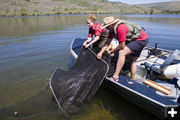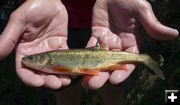

Setting trap nets
Pinedale Fish Biologists, Pete Cavalli and Jennifer Rogerson, retrieve their trap nets set to capture roundtail chubs in Little Halfmoon Lake near Pinedale in 2006. Photo by Mark Gocke.
|


Roundtail Chub
A roundtail chub captured and marked with and identification tag from Little Halfmoon Lake near Pinedale. Photo by Mark Gocke.
|
|
WGFD works to bolster struggling roundtail chubs near Pinedale
by Wyoming Game & Fish
October 27, 2009
PINEDALE ó Most people reading this have never seen, nor even heard of, a roundtail chub. Of those who have, many donít realize they exist in the waters of southwest Wyoming or that Pinedale-area waters are home to the northernmost populations of this fish that is being found in drastically lower numbers throughout their historic range. This native fish, which is a large member of the minnow family, grows to about a foot long in local waters and is found mostly in warm water streams of the Colorado River Basin.
"I had come across roundtail chubs in a lot of the warm water streams while working in Utah," says Pete Cavalli, Pinedale Fish Biologist for the Wyoming Game and Fish Department. "But when I first moved to Pinedale and heard we had some in area lakes I was shocked." When Cavalli found it to be true, he immediately started thinking of ways to help local populations because the roundtail chub, along with flannelmouth sucker and bluehead sucker, have all become prominent fixtures in the minds of fish managers in the Colorado River Basin, due to dwindling numbers of these species throughout their historic ranges.
The roundtail chub was petitioned for listing as an endangered species in the Colorado River drainage below Glen Canyon Dam in 2003. The U. S. Fish and Wildlife Service deemed that it was "warranted but precluded", meaning the petition was justified, but other species were in greater need of their conservation resources at the time. In2004, in an effort to head off potential listing of all three species, the six states across their range, Arizona, Colorado, Nevada, New Mexico, Utah and Wyoming, signed a multi-state conservation plan to try and restore their populations.
During the past several years, Pinedale fish biologists have been documenting where populations occur, estimating relative abundance and marking some fish to determine growth rates and find out if there were any movements of fish between lakes. Cavalli found relatively healthy populations in Little Halfmoon, Halfmoon and Burnt Lakes, with lesser populations in Fremont, New Fork and Willow lakes. "I donít know of any other lake populations of roundtail chubs, let alone any population this far north at such high elevation with water temperatures this cold," said Cavalli.
This past August, Cavalli and his crew took the next step to help increase distribution of the fish by arranging for a transplant from Little Halfmoon Lake to Scab Lake. "We chose Scab Lake because it has similar habitat and it doesnít hold highly predacious fish, such as lake or brown trout," said Cavalli. There is a growing belief that lake trout may have a detrimental effect on roundtail chub populations. A graduate study to learn more about this relationship is currently being conducted by the University of Wyoming.
"We started small, transplanting fewer than two hundred fish," said Cavalli. "We will monitor how they do in Scab Lake and may do additional transplants in the future."
Still, some may question, Ďwhy spend any time on a fish that most people donít fish for or eat?í. Cavalli says the fact that the fish could be listed as endangered is reason enough to care. But "As a fish manager, it is my responsibility to keep our aquatic systems as intact as possible, and that includes managing for all native nongame species as well. They play an important part in the system and it would be irresponsible if we didnít work to keep the entire system healthy."
Photos by Mark Gocke
|

